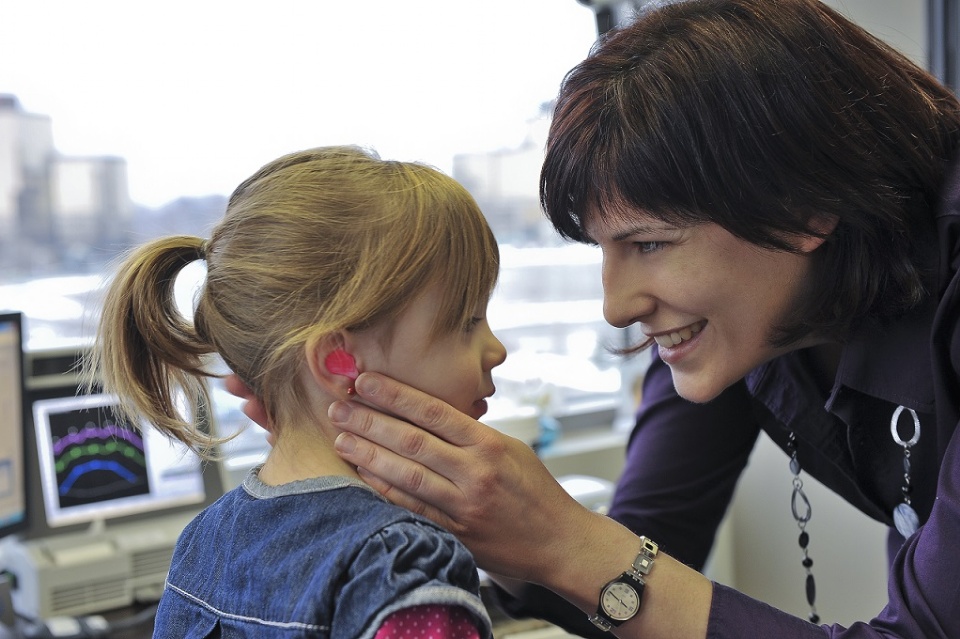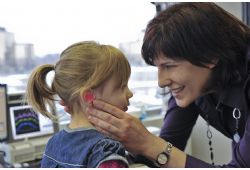Beaches,
lakes, public pools, and wading pools offer aquatic fun for kids. For parents,
these places often rhyme with earache, ear drops, ear plugs, and doctor visits.
This is not a surprise for anyone; these public places
where water activities are enjoyed are collection areas for bacteria, germs,
fungus and several other organisms. Both adults and children are exposed to
getting infections that affect the skin, the eyes, and the ears. The
transmission of viruses is also a concern. Doctors recommend trying not to open
the mouth and eyes in the water, to rinse with clean water after swimming, and
drying thoroughly the inside of the ears. Even with these precautions, it is
common for small ones to complain about painful ears a few hours or the night after
their swim.
Over 75<>percentage<> of little ones will suffer from otitis at
least once before the age of three. The phenomenon is a combination of
swimmer’s ear and otitis media cases. Swimmer’s ear (external otitis) is very
common, and occurs when infection develops in the ear canal from bacteria in
the water. Heat, humidity and ideal Ph make the ear a great nesting ground for
bacteria. Since it is difficult to dry the ear canal thoroughly after swimming,
external otitis is very common. The infection occurs in the ear canal,
somewhere between the ear opening and the eardrum.
Otitis media is different and affects a different par
of the ear, the middle ear. It usually develops after a cold or allergy. The
eustachian tubes are little canals that link the middle ear (the part of the
ear behind the eardrum) and throat. Their purpose is to evacuate any liquid
that could accumulate in the ears, as well as to equalize the air pressure on
both sides of the eardrum. Kids are particularly sensitive because their
eustachian tubes are much narrower and lay much more horizontally than those of
adults. This makes it more difficult for liquid to be evacuated. The liquid that accumulates behind the
eardrum can easily get infected and cause otitis. If the problem persists or
repeats itself often, the doctor might suggest inserting a tube through the
eardrum to facilitate liquid evacuation.
When a tube is inserted, pool water, contaminated with
bacteria, might access the middle ear through the tube opening. The eardrum can
no longer block water from entering directly the middle ear. The risk of infection
is significantly increased. To decrease and deal with that risk, as well as to
prevent swimmer’s ear, doctors often recommend wearing ear plugs to keep water from
entering the ear canal. You can get them custom made by an audioprosthetist for
optimal comfort and waterproofing.
In both otitis types, the little one will complain
about pain and/or blocked ear. Irritability and fever often come along. At
home, refrain from using cotton swabs that make the ear more prone to
infections. Heat applied on the ear might help soothe the pain temporarily, but
it is very important to go see a doctor as soon as possible. He will indicate
what the best treatment is for your child. Happy swimming!

 In The Latest Issue:Latest Issue:
In The Latest Issue:Latest Issue:
- A Bittersweet Farewell
- The new Laval Aquatic Co...
- The End of an Era:
Articles
Calendar
Virtual- ANNUAL TEACHER APPRECIATION CONTEST
- APPUI LAVAL
- ARTS & CULTURE
- CAMPS
- CAR GUIDE
- CCIL
- CENTENNIAL ACADEMY
- CHARITY FUNDRAISING
- CITYTV
- COSMODÔME
- COMMUNITY CONNECTIONS
- COVER STORY
- DINA DIMITRATOS
- ÉCOLE SUPÉRIEURE DE BALLET DU QUÉBEC
- EDITORIALS
- ÉDUCALOI
- EDUCATION
- EMPLOYMENT & ENTREPRENEURSHIP
- FÊTE DE LA FAMILLE
- FÊTE DU QUARTIER SAINT-BRUNO
- FAMILIES
- FESTIVAL LAVAL LAUGHS
- FÊTE DE QUARTIER VAL-DES-BRISES
- FINANCES
- GLI CUMBARE
- GROUPE RENO-EXPERT
- HEALTH & WELL-BEING
- 30 MINUTE HIT
- ANXIETY
- CHILDREN`S HEALTH & WELLNESS
- CLOSE AID
- DENTAL WELLNESS
- EXTREME EVOLUTION SPORTS CENTRE
- FONDATION CITÉ DE LA SANTÉ
- GENERAL
- HEARING HEALTH
- MESSAGES FROM THE HEALTH AGENCY OF CANADA
- MENTAL HEALTH
- SEXUALITY
- SOCIAL INTEGRATION
- SPECIAL NEEDS
- TEENS
- THE NUTRITION CORNER
- THE NUTRITION CORNER - RECIPES
- VACATION DESTINATION
- WOMEN'S FITNESS
- WOMEN'S HEALTH
- HILTON MONTREAL/LAVAL
- HOME & GARDEN
- INTERNATIONAL WOMEN'S DAY
- JAGUAR LAVAL
- LAVAL À VÉLO
- LAVAL FAMILIES TV SHOW
- LAVAL FAMILIES MAGAZINE CARES
- LAVAL URBAN IN NATURE
- LE PARCOURS DES HÉROS
- LES PETITS GOURMETS DANS MA COUR
- LEON'S FURNITURE
- LEONARDO DA VINCI CENTRE
- LFM PREMIERES
- LIFE BALANCE
- M.P. PROFILE
- MISS EDGAR'S AND MISS CRAMP'S SCHOOL
- MISSING CHILDREN'S NETWORK
- NETFOLIE
- NORTH STAR ACADEMY LAVAL
- OUTFRONT MEDIA
- PASSION SOCCER
- PARC DE LA RIVIÈRE-DES-MILLE-ÎLES
- PÂTISSERIE ST-MARTIN
- PIZZERIA LÌOLÀ
- PLACE BELL
- PORTRAITS OF YOUR MNA'S
- ROCKET DE LAVAL
- SACRED HEART SCHOOL
- SCOTIA BANK
- SHERATON LAVAL HOTEL
- SOCIÉTÉ ALZHEIMER LAVAL
- STATION 55
- STL
- SUBARU DE LAVAL
- TECHNOLOGY
- TEDXLAVAL
- TODAY`S LAURENTIANS AND LANAUDIÈRE
- TODAY`S LAVAL
- WARNER MUSIC
- THIS ISSUE
- MOST RECENT
Magazine
Little Swimmers, Little Ears
Articles ~e 105,7 Rythme FM 4 chemins Annual Teacher Appreciation Contest Appui Laval Arts & Culture Ballet Eddy Toussaint Camps THIS ISSUE MORE...
CONTESTS Enter our contests
CONTESTS Enter our contests
CALENDAR
Events & Activities
COMMUNITY Posts Events
PUBLICATIONS Our Magazine Family Resource Directory
LFM BUSINESS NETWORK Learn more
COUPONS Click to save!
COMMUNITY Posts Events
PUBLICATIONS Our Magazine Family Resource Directory
LFM BUSINESS NETWORK Learn more
COUPONS Click to save!
SUBSCRIPTIONS
Subscribe to the magazine
Un-Subscribe
E-NEWSLETTER Subscribe to our E-newsletter Un-Subscribe
WRITE FOR US Guidelines & Submissions
POLLS Vote today!
E-NEWSLETTER Subscribe to our E-newsletter Un-Subscribe
WRITE FOR US Guidelines & Submissions
POLLS Vote today!
ADVERTISERS
How to & Media guide
Pay your LFM invoice
SUGGESTIONS Reader's Survey Suggest a Listing
LFM About Us Our Mission Giving Back Contact Us
SUGGESTIONS Reader's Survey Suggest a Listing
LFM About Us Our Mission Giving Back Contact Us
 PICK-UP LOCATIONS
Get a copy of LFM!
PICK-UP LOCATIONS
Get a copy of LFM!
TERMS & CONDITIONS Privacy | Terms
ISSN (ONLINE) 2291-1677
ISSN (PRINT) 2291-1677
Website by ZENxDESIGN




 BY:
BY: 
Tweet
Share